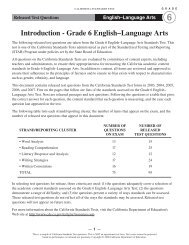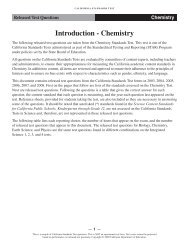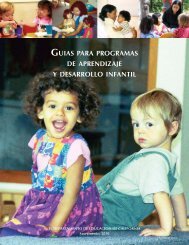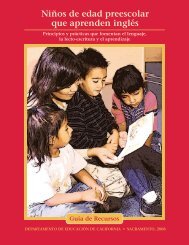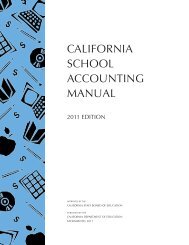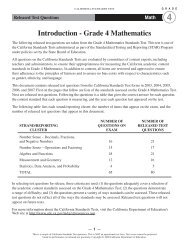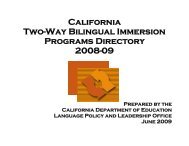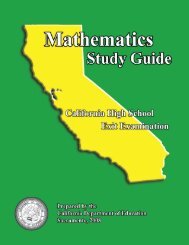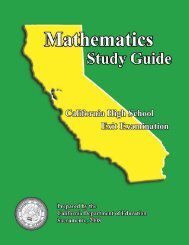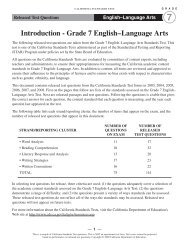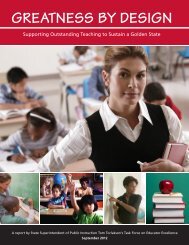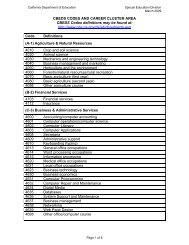Grade 2 - California Department of Education
Grade 2 - California Department of Education
Grade 2 - California Department of Education
You also want an ePaper? Increase the reach of your titles
YUMPU automatically turns print PDFs into web optimized ePapers that Google loves.
State Board <strong>of</strong> <strong>Education</strong>-Adopted <strong>Grade</strong> Two Page 7 <strong>of</strong> 45<br />
113<br />
114<br />
115<br />
116<br />
117<br />
118<br />
119<br />
120<br />
121<br />
122<br />
123<br />
experiences working with various problem situations (add to, take from, put together,<br />
take apart, and compare) with unknowns in all positions (result unknown, change<br />
unknown, and start unknown). <strong>Grade</strong> two students extend their work with addition and<br />
subtraction word problems in two major ways:<br />
• They represent and solve problems <strong>of</strong> all types which involve addition and<br />
subtraction within 100, building upon their previous work within 20, and<br />
• They represent and solve two-step word problems <strong>of</strong> all types, extending their<br />
work with one-step word problems.<br />
(Adapted from Arizona 2012, N. Carolina 2013, Georgia <strong>Department</strong> <strong>of</strong> <strong>Education</strong><br />
[Georgia] 2011, and the Kansas Association <strong>of</strong> Teachers <strong>of</strong> Mathematics [KATM] 2 nd<br />
FlipBook 2012)<br />
124<br />
125<br />
The various addition and subtraction problem types are listed in the following table.<br />
<strong>Grade</strong> Two Addition and Subtraction Problem Types.<br />
Add To (with change unknown): “Bill had 25 baseball cards. His mom gave him some more. Now he<br />
has 73 baseball cards. How many baseball cards did his mom give him?”<br />
In this problem the starting quantity is provided (25 baseball cards), a second quantity is added to that<br />
amount (some baseball cards) and the result quantity is given (73 baseball cards). This question type is<br />
more algebraic and challenging than the “result unknown” problems and can be modeled by a situational<br />
equation 25 + □ = 73, which does not immediately lead to the answer. Students can write a related<br />
equation, 73 – 25 = □ (called a solution equation) to solve the problem.<br />
Take From (with change unknown): “Andrea had 51 stickers. She gave some stickers away. Now she<br />
has 22 stickers. How many stickers did she give away?”<br />
This question can be modeled by a situational equation 51 − □ = 22 or a solution equation 51 – 22 = □.<br />
Both the Take From and Add To questions involve actions.<br />
Add to (with start unknown): Some children were playing in the playground. 5 more children joined<br />
them. Then there were 22 children. How many children were playing before?”<br />
This problem can be represented by □ + 5 = 22. The “start unknown” problems are difficult for students to<br />
model because the initial quantity is unknown and therefore some students do not know how to start a<br />
solution strategy. They can make a drawing, where it is key that they realize that the 5 is part <strong>of</strong> the 22<br />
total children. This leads to more general solutions by subtracting the known addend or counting/adding<br />
on from the known addend to the total.<br />
Take From (with start unknown): Some children were lining up for lunch. 4 children left and then there<br />
were 26 children still waiting in line. How many children were there before?<br />
This problem can be modeled by □ – 4 = 26. Similar to the previous Add To (start unknown) problem, the<br />
Take From problems with the “start unknown” require a high level <strong>of</strong> conceptual understanding. Students<br />
need to understand that the total is first in a subtraction equation, and that this total is broken apart into<br />
the 4 and the 26.<br />
Put Together/Take Apart (with addend unknown): Roger puts 24 apples in a fruit basket. 9 are red<br />
The Mathematics Framework was adopted by the <strong>California</strong> State Board <strong>of</strong> <strong>Education</strong> on November 6,<br />
2013. The Mathematics Framework has not been edited for publication.



